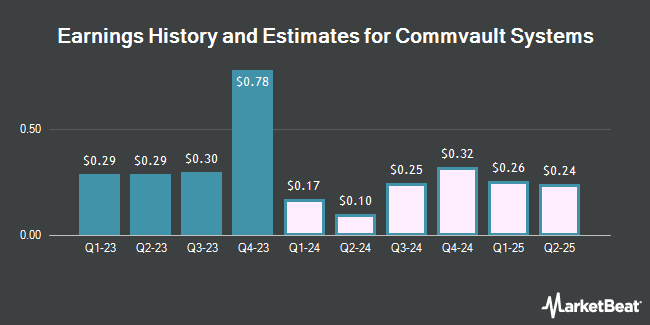 Equities research analysts expect CommVault Systems, Inc. (NASDAQ:CVLT) to report $178.48 million in sales for the current fiscal quarter, according to Zacks Investment Research. Five analysts have made estimates for CommVault Systems’ earnings. The highest sales estimate is $179.00 million and the lowest is $177.70 million. CommVault Systems reported sales of $165.97 million in the same quarter last year, which would suggest a positive year over year growth rate of 7.5%. The firm is expected to report its next earnings report on Tuesday, July 24th.
Equities research analysts expect CommVault Systems, Inc. (NASDAQ:CVLT) to report $178.48 million in sales for the current fiscal quarter, according to Zacks Investment Research. Five analysts have made estimates for CommVault Systems’ earnings. The highest sales estimate is $179.00 million and the lowest is $177.70 million. CommVault Systems reported sales of $165.97 million in the same quarter last year, which would suggest a positive year over year growth rate of 7.5%. The firm is expected to report its next earnings report on Tuesday, July 24th.
According to Zacks, analysts expect that CommVault Systems will report full year sales of $767.60 million for the current fiscal year, with estimates ranging from $763.70 million to $772.50 million. For the next fiscal year, analysts anticipate that the company will report sales of $848.14 million per share, with estimates ranging from $835.00 million to $871.50 million. Zacks Investment Research’s sales averages are an average based on a survey of analysts that follow CommVault Systems.
Get CommVault Systems alerts:
CommVault Systems (NASDAQ:CVLT) last announced its earnings results on Tuesday, May 1st. The software maker reported $0.31 earnings per share for the quarter, missing analysts’ consensus estimates of $0.33 by ($0.02). CommVault Systems had a negative return on equity of 0.12% and a negative net margin of 8.85%. The business had revenue of $184.90 million during the quarter, compared to analysts’ expectations of $187.01 million. During the same quarter in the previous year, the firm earned $0.29 EPS. CommVault Systems’s quarterly revenue was up 10.9% on a year-over-year basis.
CVLT has been the topic of a number of research analyst reports. BidaskClub upgraded CommVault Systems from a “strong sell” rating to a “sell” rating in a research note on Thursday, March 8th. Zacks Investment Research upgraded CommVault Systems from a “sell” rating to a “hold” rating in a research note on Friday, March 9th. Jefferies Financial Group restated a “buy” rating and issued a $76.00 target price on shares of CommVault Systems in a research note on Monday, April 2nd. ValuEngine upgraded CommVault Systems from a “hold” rating to a “buy” rating in a research note on Monday, April 2nd. Finally, Wells Fargo & Co lifted their price target on shares of CommVault Systems from $64.00 to $75.00 and gave the stock an “outperform” rating in a report on Tuesday, April 3rd. Five equities research analysts have rated the stock with a hold rating and nine have assigned a buy rating to the stock. The stock has an average rating of “Buy” and a consensus target price of $75.10.
Shares of NASDAQ CVLT traded up $0.70 during midday trading on Thursday, reaching $68.25. The company’s stock had a trading volume of 113,358 shares, compared to its average volume of 392,869. CommVault Systems has a 12-month low of $48.35 and a 12-month high of $72.65. The company has a market capitalization of $3.07 billion, a PE ratio of -115.68, a PEG ratio of 12.43 and a beta of 1.21.
In other CommVault Systems news, VP Brian Carolan sold 5,470 shares of the business’s stock in a transaction on Tuesday, April 10th. The shares were sold at an average price of $67.90, for a total transaction of $371,413.00. Following the sale, the vice president now owns 88,404 shares of the company’s stock, valued at approximately $6,002,631.60. The sale was disclosed in a legal filing with the Securities & Exchange Commission, which is available at this hyperlink. Also, insider Gary Merrill sold 12,346 shares of the business’s stock in a transaction on Wednesday, June 13th. The shares were sold at an average price of $71.90, for a total transaction of $887,677.40. Following the sale, the insider now directly owns 31,520 shares in the company, valued at approximately $2,266,288. The disclosure for this sale can be found here. Insiders have sold a total of 62,077 shares of company stock worth $4,343,850 in the last three months. Insiders own 13.40% of the company’s stock.
Several institutional investors and hedge funds have recently added to or reduced their stakes in CVLT. ETF Managers Group LLC purchased a new position in shares of CommVault Systems during the 1st quarter valued at $62,229,000. Wells Fargo & Company MN grew its position in shares of CommVault Systems by 193.8% during the 4th quarter. Wells Fargo & Company MN now owns 545,215 shares of the software maker’s stock valued at $28,624,000 after purchasing an additional 359,612 shares in the last quarter. TIAA CREF Investment Management LLC grew its position in shares of CommVault Systems by 92.4% during the 4th quarter. TIAA CREF Investment Management LLC now owns 457,712 shares of the software maker’s stock valued at $24,030,000 after purchasing an additional 219,804 shares in the last quarter. Lunia Capital LP purchased a new position in shares of CommVault Systems during the 4th quarter valued at $10,578,000. Finally, Mesirow Financial Investment Management Equity Management purchased a new position in shares of CommVault Systems during the 1st quarter valued at $10,519,000. Hedge funds and other institutional investors own 93.53% of the company’s stock.
About CommVault Systems
Commvault Systems, Inc provides data protection and information management software applications and related services in the United States, Canada, Latin America, Europe, the Middle East, Africa, Australia, New Zealand, Southeast Asia, and China. The company offers data protection, backup, and recovery software solutions for the backup of databases, files, applications, endpoints, and virtual machines according to data type and recovery profile; and help to optimize storage with deduplication, recover data, and leverage reports.
Get a free copy of the Zacks research report on CommVault Systems (CVLT)
For more information about research offerings from Zacks Investment Research, visit Zacks.com




 Rivernorth Opportunities Fund Inc (NYSE:RIV) announced a monthly dividend on Thursday, July 19th, Wall Street Journal reports. Investors of record on Wednesday, October 17th will be given a dividend of 0.21 per share on Wednesday, October 31st. This represents a $2.52 dividend on an annualized basis and a dividend yield of 12.97%. The ex-dividend date of this dividend is Tuesday, October 16th.
Rivernorth Opportunities Fund Inc (NYSE:RIV) announced a monthly dividend on Thursday, July 19th, Wall Street Journal reports. Investors of record on Wednesday, October 17th will be given a dividend of 0.21 per share on Wednesday, October 31st. This represents a $2.52 dividend on an annualized basis and a dividend yield of 12.97%. The ex-dividend date of this dividend is Tuesday, October 16th. 